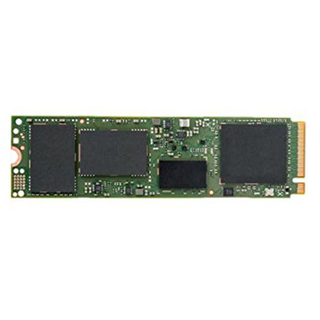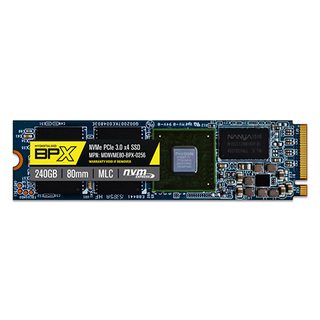Drevo Ares NVMe SSD Review
Why you can trust Tom's Hardware
256GB NVMe SSD Performance Testing
Comparison Products
The Drevo Ares 256GB falls into the low-cost NVMe arena with a price point very close to the Intel 600p, MyDigitalSSD BPX, and Patriot Hellfire M.2. This is a small but growing product segment. We expect explosive growth by early 2018 as Phison E8 and SMI SM2263 products come to market.
The 256GB NVMe class isn't a hot topic for enthusiasts. Most of us look for NVMe SSDs in 512GB or larger capacities. Samsung didn't even release a 256GB 960 Pro, but it did use the Polaris controller in the OEM SM961 SSD we tested last year. The Samsung 950 Pro, provided you can still find one, delivers the lowest latency in this capacity. The Intel 600p is readily available and is the least expensive NVMe SSD on the market. If price is your primary concern, the MyDigitalSSD BPX is widely considered the most well-rounded product in 256GB and 512GB capacities.
Sequential Read Performance
To read about our storage tests in-depth, please check out How We Test HDDs And SSDs. We cover four-corner testing on page six of our How We Test guide.


Drevo says the Ares 256GB will deliver up to 1,400 MB/s of sequential read throughput, but we nearly hit 2,000 MB/s at a queue depth (QD) of 8. The drive features the same controller as the Intel 600p, and both suffer from low QD1 performance. The two drives deliver similar performance up to QD4, but the Ares jumps ahead of the Intel when we intensify the workload.
Sequential Write Performance


It's difficult to hit the rated 600 MB/s of sequential write speed. We do attain the hero number, but only for a brief time. Our test shows the average over an extended period of time, so the brief SLC cache boost only helps a little.
We have the same issue with the Intel 600p. Surprisingly, the Ares with 3D MLC flash comes up short of the Intel 600p and its slower 3D TLC NAND.
Sustained Sequential Write Performance
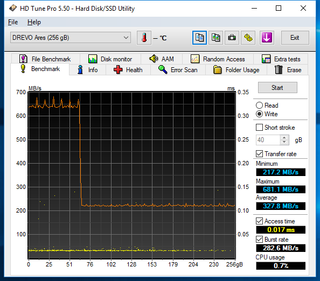
This test writes 128KB sequential data across the entire usable LBA range. The Ares 256GB can actually write up to 680 MB/s, but the drop off to native TLC speed happens once you fill the drive to roughly 25%. Then performance drops to around 220 MB/s. This transition occurs because the SLC buffer shrinks according to how much data you store on the drive.
Random Read Performance



The Ares and 600p share nearly identical low-QD random read performance, but the Drevo's MLC flash scales better as we ramp up the workload. This is the one aspect that we don't like about the Drevo Ares. High-performance SATA SSDs deliver up to 10,000 random read IOPS at QD1. That's the mark we use to separate the best consumer SSDs from mainstream products, and we naturally expect NVMe SSDs to reach that benchmark.
Random Write Performance



Cache technology has made random write performance much less of a concern. Early SSDs had stuttering issues due to high random write latency. SSD vendors quickly learned how to correct the issues. Since then, random write performance has become a gloss-over specification for consumer use.
80% Mixed Sequential Workload
We describe our mixed workload testing in detail here and describe our steady state tests here.

Mixed random performance is a hot topic because your operating system rarely just reads or writes data serially. Instead, the operating system attempts to issue simultaneous read and write commands. The SATA interface doesn't allow you to read and write data at the same time, but the NVMe protocol does. That's one of the reasons why NVMe SSDs feel so much faster than SATA during real-world use.
The Drevo Ares 256GB slots in the middle of the group during our 80% mixed sequential workload. It delivers outstanding mixed workload performance compared to SATA.
80% Mixed Random Workload

The drive also performs well compared to the Intel 600p in mixed random workloads. With just a $20 difference in pricing, you should take a very close look at the Ares if you already have the 600p on your wish list.
Sequential Steady-State



Even though it clearly looks the part, Drevo didn’t design the Ares for steady-state workloads. The dual-core controller paired with 384Gbit TLC flash can't keep pace with the premium NVMe SSDs. However, the low-cost NVMe drives do run a little faster than most SATA SSDs in steady state, particularly in the key mixtures, such as 80% (desktop) and 70% (workstation).
Random Steady-State


The random steady-state test shows how the SM2260's cache system sacrifices consistency for high burst performance. A large rush of data will fill the SLC buffer, but then the SSD has to flush the buffered data to the TLC pool. That slows down the incoming data, again.
SLC caching works great as long as you don't need to transfer more data at one time than the SLC buffer can absorb. The Ares features a dynamic SLC buffer capacity. We aren't sure how much data can fit into the buffer because its capacity changes based on the amount of data stored on the drive.
PCMark 8 Real-World Software Performance
For details on our real-world software performance testing, please click here.










The Drevo Ares 256GB consistently outperforms the Intel 600p's service time, but it falls behind the other NVMe SSDs. The 600p and the Ares are the two least expensive drives in our lineup, so we don't mind the lower performance.
Application Storage Bandwidth
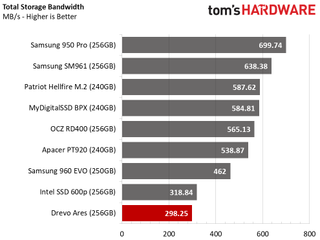
It's rare to see a product outperform another in the service time tests but then trail in the throughput results. Both the 600p and Ares provide similar performance, but there is a latency difference between the two. The Ares can finish the task faster than the 600p, but oddly enough, the 600p returns to an idle state quicker.
PCMark 8 Advanced Workload Performance
To learn how we test advanced workload performance, please click here.



The recovery test doesn't look good for the Drevo Ares because it needs more time to recover than the test allows. The dual-core processor was never very good for background tasks to start with, but the 256Gbit 3D flash introduces another set of issues. These two factors can amplify latency during severe workloads.
Total Service Time



The service time results show the MLC-based Ares with the same high result as the two TLC-based products. The TLC-powered Intel 600p and Samsung 960 EVO recover within the five minute idle time during the recovery phases of the test, but the Ares doesn't fare as well. Drevo could address this issue with a firmware update.
Disk Busy Time
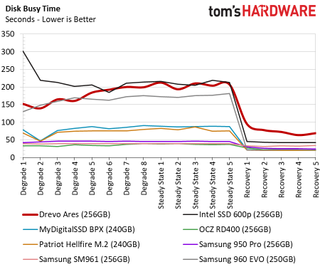
The disk busy time test shows us more of the same. The Ares was not built to tackle heavy workloads, and it doesn't handle adversity well.
MORE: Best SSDs
MORE: How We Test HDDs And SSDs
MORE: All SSD Content
Current page: 256GB NVMe SSD Performance Testing
Prev Page Features & Specifications Next Page ConclusionStay on the Cutting Edge
Join the experts who read Tom's Hardware for the inside track on enthusiast PC tech news — and have for over 25 years. We'll send breaking news and in-depth reviews of CPUs, GPUs, AI, maker hardware and more straight to your inbox.
-
spdragoo I gotta say, that switch on the back is definitely not appealing. Aside from not seeing the point of any kind of physical switch to adjust performance on a storage drive (I think software control would have been better), I think a selector dial would have made more sense. Less chance of accidentally changing the selection when fiddling with the back of your PC.Reply -
cryoburner Reply
I was thinking this as well. Why would you want a toggle switch on the back of your computer that serves no purpose other than to cripple your SSD's performance? Even a dial could get nudged when reaching behind the case to plug in a cable. It they really wanted a switch to marginally reduce power consumption at the expense of performance, why not put in inside the case? It's not like anyone's going to be flipping the switch on a regular basis.20355478 said:Less chance of accidentally changing the selection when fiddling with the back of your PC.
The Ares has a big endurance advantage over the 600p. Intel rates the 600p 256GB at 144 TBW, which is less than half of the Ares' 350 TBW rating. Endurance may not seem like a significant issue, but many shoppers looking at SSDs in this price range want to keep using the drive for several years rather than upgrade frequently.
Even this is practically useless. I can't really imagine many scenarios in which someone would be writing 144TB to one of these drives, let alone 350TB. If you averaged 10GB of writes per day, it should take you nearly 40 years to wear out the flash memory on a 144TBW drive. More than likely, some other component on the SSD, like a capacitor, will fail long before that point. In order to hit 144TB of writes within the 600p's 5-year warranty, you would need to write an average of almost 80GB of data to the drive every single day. That's nearly one-third of the drive's total capacity.
Perhaps more worth noting to someone interested in keeping their drive for a number of years is that the Drevo Ares only offers a 3-year warranty, as opposed to the 5 years for the Intel 600p. In order to write 350TB to the drive within its warranty period, you would need to write around 320GB to the drive every day. Or over 190GB per day if you were using it for the same 5 years compared for the Intel drive. 190GB of writes per day might be more than 80GB, but either one is far higher than any likely usage scenario on a 256GB consumer SSD, to the point where any differences in write endurance don't even matter. So no, the Ares does not have "a big endurance advantage over the 600p". If anything, the shorter warranty might be more of a concern for someone planning to keep the drive for a long time. -
takeshi7 That switch on the back is absolutely pointless and it's an eyesore. It's a nice looking budget AIC meant for desktops. Just ship it from the factory in the highest performance mode and get rid of that stupid switch.Reply -
joz They wan't how much for this piece of excrement? Holy excrement.Reply
Moderator edited for language. -
mlee 2500 Gotta ask yourself:Reply
How mad and/or stupid are you going to feel when you discover that you've been inadvertently running at half speed because the switch moved unbeknownst to you, the last time you reached behind your PC to unplug a monitor, attach a USB cable etc? -
MxMatrix It looks like a product targeted for the chinese market. Cheap and sort of swag. Just missing the bling of a staple gun.Reply -
yonatanhak See the Electrolytic capacitors at the top?Reply
These are cheap, lifetime limited devices.
This a sign of a product they have cut every corner on the worst.
Don't be blinded by a blue led.. -
Darkbreeze And again, this is another product that has half the performance of the 960 EVO but costs 70 dollars more. Ok, 55 dollars more if you factor in the cost of an M.2 to PCIe adapter for those who don't have native M.2.Reply
AND, this one doesn't even have a longer warranty. What makes these companies think they can compete like this and why do we promote them in such a positive light when there are so many better, cheaper options?
